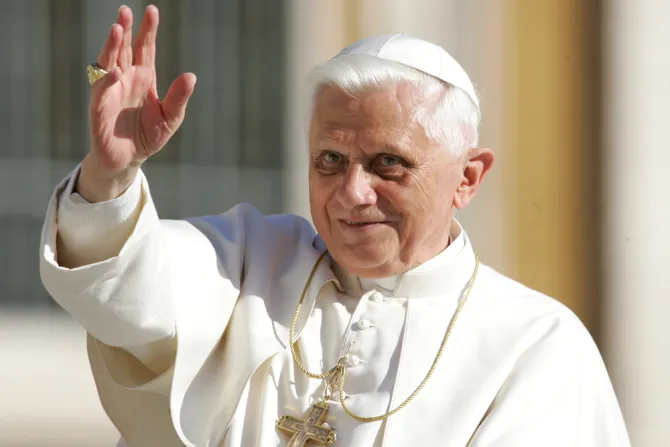Here is a look back at the key dates and events in the life of Pope Benedict XVI:
1927 — Joseph Ratzinger is born on Holy Saturday, April 16, in the Bavarian town of Marktl am Inn, Germany, and is baptized on that same day.
1936 — Ratzinger makes his first Communion in the parish church of the Assumption of Our Lady on March 15.
1937 — Cardinal Michael von Faulhaber administers the sacrament of confirmation to 10-year-old Joseph Ratzinger on June 9 in the Traunstein, Germany, parish church of St. Oswald.
1939 — At age 12, Ratzinger enters a minor seminary in Traunstein in the same year that German dictator Adolf Hitler orders the invasion of Poland and World War II begins.
1941 — By law, Ratzinger is required to enter the “Hitler Youth” at age 14. He finds the group wretched and never wears his uniform, according to Benedict XVI’s biographer, Peter Seewald.
1943 — At age 16, he is drafted into the German army and conscripted into the military’s auxiliary anti-aircraft service. He is sent to Hungary where he sets tank traps in the final months of World War II.
1945 — Ratzinger deserts the army with his brother, Georg, to rejoin the seminary. He is briefly held in a prisoner of war camp. Benedict would later say that the Nazis led “a sinister regime” that “banished God and thus became impervious to anything true and good.”
1946–1951 — He studies philosophy and theology at the University of Munich and at the higher school in Freising.
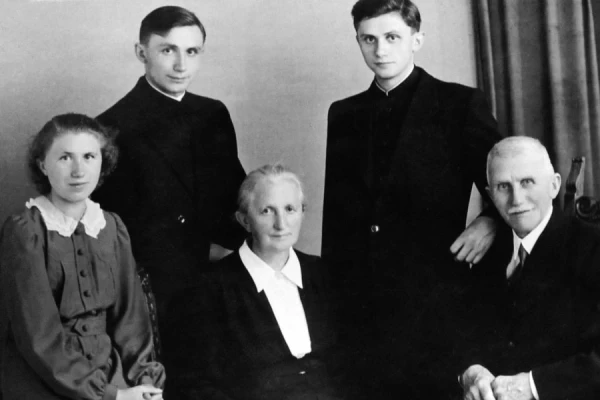
1951
June 29 — Ratzinger is ordained a priest on the feast of Sts. Peter and Paul in the Freising Cathedral in the Diocese of Munich together with his brother, Georg.
July 8 — The future pope offers his first Mass in St. Oswald’s in Traunstein. It is a High Mass with the music of Joseph Haas’ opus 88 Mass of Christ the King.
1953 — Ratzinger completes his doctorate degree in theology at the University of Munich. His thesis is titled “The People and House of God in St. Augustine’s Doctrine of the Church.”
1957 — The priest qualifies as a university professor teaching dogma and fundamental theology at the higher school of philosophy and theology of Freising. He would teach in Bonn from 1959 to 1969, in Münster from 1963 to 1966, and in Tübingen from 1966 to 1969.
1962–1965 — Ratzinger acts as a theological adviser during the Second Vatican Council in Rome for Cardinal Joseph Frings, the archbishop of Cologne. He attends all four sessions of the Council.
1969 — Ratzinger is named professor of dogmatic theology and the history of dogma at the University of Regensburg. In a German radio broadcast, he predicts that the Catholic Church will be a smaller and “a more spiritual Church” in the future.
1972 — Ratzinger co-founds the theological journal Communio with Hans Urs von Balthasar and Henri De Lubac.
1977
March 24 — Pope Paul VI names Ratzinger archbishop of Munich and Freising.
May 28 — Ratzinger is consecrated as a bishop, choosing the episcopal motto “Fellow Worker in the Truth.”
June 27 — Pope Paul VI makes Ratzinger a cardinal in a consistory in St. Peter’s Basilica.
1981 — Pope John Paul II appoints Ratzinger to serve as the prefect for the Vatican’s Congregation for the Doctrine of the Faith.
1982 — Ratzinger moves to Italy to join the Roman Curia. He resigns as archbishop of Munich and Freising on Feb. 15, 1982. He also serves as the president of the Biblical Commission and of the Pontifical International Theological Commission.
1986–1992 — Ratzinger serves as president of the Commission for Drafting the Catechism of the Catholic Church.
1997 — Ratzinger asks Pope John Paul II to allow him to resign his curial position so that he could work in the Vatican Library, but he is denied.
2002 — Ratzinger becomes dean of the College of Cardinals at age 75.
2005
April 8 — Ratzinger presides over Holy Mass for the funeral of Pope John Paul II.

April 19 — Ratzinger is elected the 265th pontiff of the Roman Catholic Church and takes the name Benedict XVI.
June — Two months into his papacy, Benedict disciplines Father Marcel Maciel Degollado, founder of the Legionaries of Christ, who had been accused of sexually abusing seminarians and fathering children.
Aug. 17 — Benedict visits his native Germany for World Youth Day in Cologne in his first international trip as pope.
2006
Jan. 25 — Benedict XVI promulgates the encyclical Deus Caritas Est (God Is Love).
May 26 — The pope visits the Auschwitz concentration camp during a pastoral visit to Poland.
Sept. 12 — Benedict delivers “The Regensburg Address.”
Nov. 30 — The pope visits Turkey, where he prays silently alongside Muslim leader Mustafa Cagrici at Istanbul’s Blue Mosque.
2007
May 15 — The pope’s book, “Jesus of Nazareth,” is published in the United States.
May 27 — Pope Benedict pens a letter to Catholics in China.
July 7 — The pope promulgates Summorum Pontificum, which significantly broadens permission for priests to celebrate Mass in Latin according to the 1962 missal.
July 13 — Pope Benedict XVI announces that the Vatican will become the world’s first “carbon neutral” state.
Nov. 30 — The Vatican publishes Benedict’s encyclical Spe Salvi on the virtue of hope.
2008
April 15–20 — Benedict XVI visits the United States, where he meets with sex abuse victims in Boston, addresses the United Nations, greets President George W. Bush at the White House, visits Ground Zero, and offers Mass in Yankee Stadium.
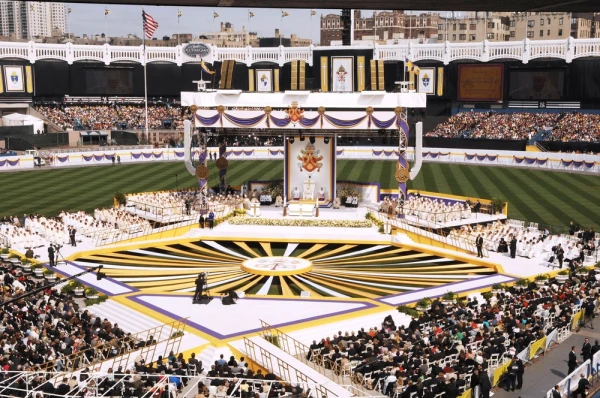
June 28 — The pope opens the Church’s Year of St. Paul at the Basilica of St. Paul Outside the Walls in Rome.
July 13–21 — Benedict XVI visits Australia for World Youth Day and makes a historic apology for clerical sex abuse during his trip.
Oct. 26 — The pope opens the Synod of Bishops on the Word of God in the Life and Mission of the Church at the Vatican.
2009
Jan. 23 — Benedict XVI launches a Vatican YouTube channel.
May 8–15 — During an apostolic journey to the Holy Land, Benedict XVI visits Jordan, Israel, and the Palestinian territories, where he calls for cooperation between Palestinians and Israelis.
June 19 — The pope opens the Church’s Year for Priests, which lasts until June 19, 2010.
July 7 — Benedict promulgates the encyclical Caritas in Veritate (Charity in Truth).
July 10 — The pope receives U.S. President Barack Obama in a private audience at the Vatican.
July 17 — Benedict spends six weeks in a cast after falling and breaking his wrist while on summer vacation.
Oct. 4 — The pope presides over the opening Mass in St. Peter’s Basilica for the special synod of bishops for Africa.
Nov. 4 — Benedict XVI signs the apostolic constitution Anglicanorum Coetibus on personal ordinariates for Anglicans entering into full communion with the Catholic Church.
Dec. 3 — Pope Benedict XVI opens the Holy See’s diplomatic relations with Russia after a private meeting with President Dmitri A. Medvedev.
2010
March 20 — Benedict publishes a pastoral letter to Catholics in Ireland in light of the sex abuse crisis.
April 2 — Pope Benedict XVI venerates the Holy Shroud in Turin, Italy.
Sept. 16–19 — The pope travels to the United Kingdom, where he presides over the beatification of Cardinal John Henry Newman.
Oct. 10 — Pope Benedict offers the opening Mass for the special Synod of Bishops for the Middle East.
Nov. 6–7 — Benedict visits the historic pilgrimage site of Santiago de Compostela, Spain, for its Holy Year and consecrates Barcelona’s Sagrada Familia church.
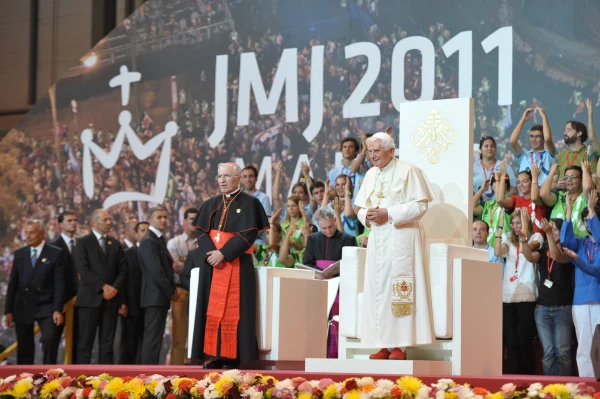
2011
May 1 — Pope Benedict XVI presides over the beatification of Pope John Paul II in St. Peter’s Square.
Aug. 18 — Benedict participates in World Youth Day in Madrid, Spain.
Sept. 22–25 — Benedict XVI makes his third and final visit as pope to his native country of Germany.
2012
Jan. 6 — Benedict XVI names 22 new cardinals, including Cardinal Timothy Dolan of New York.
March 23–29 — The pope visits Mexico and Cuba.
Sept. 14–16 — Benedict XVI visits Lebanon in what will be the last international trip of his pontificate.
Oct. 6 — The pope’s former butler, Paolo Gabriele, is sentenced to more than a year in prison for stealing documents from the Vatican.
Oct. 7 — Benedict XVI proclaims St. John of Ávila and St. Hildegard of Bingen doctors of the Church.
Oct. 11 — The pope opens the Church’s Year of Faith.
Oct. 21 — Pope Benedict canonizes seven saints, including St. Kateri Tekakwitha.
Oct. 28 — He offers the closing Mass for the Synod of Bishops on the new evangelization.
Dec. 12 — Benedict becomes the first pope to post on Twitter, using the account @Pontifiex.
2013
Feb. 11 — Benedict XVI shocks the world with a Latin-language announcement of his retirement at age 85.
Feb. 14 — In his final public words as pope, Benedict says: “I’m simply a pilgrim who is starting the last stage of his pilgrimage on Earth.”
Feb. 28 — Taking the title “pope emeritus,” Benedict travels from Vatican City to Castel Gandolfo by helicopter.
May 2 — Benedict moves into the Mater Ecclesiae Monastery, a small four-story building within the walls of Vatican City State. He will remain there in quiet retirement until his death.
2014
Feb. 22 — Pope Emeritus Benedict XVI emerges from seclusion to attend his successor’s first consistory for the creation of new cardinals.
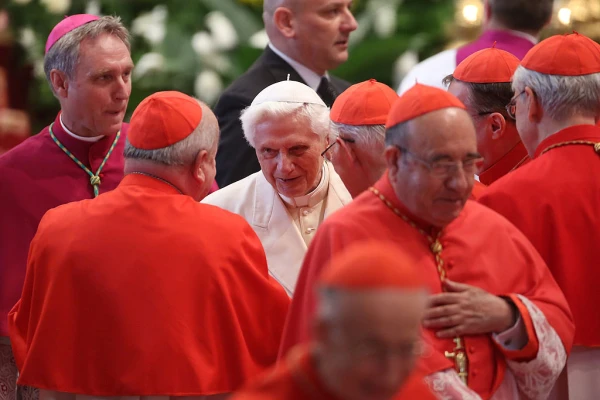
April 27 — The pope emeritus attends the canonization of Blessed John Paul II and Blessed John XXIII in St. Peter’s Square.
Sept. 28 — Pope Francis describes Benedict as “a wise grandfather.”
2015 — Pope Emeritus Benedict attends the launch of Pope Francis’ Holy Year of Mercy.
2016 — Archbishop Georg Gänswein, the pope emeritus’ longtime personal secretary, says that Benedict XVI is using a walker to help him get around.
2019 — Pope Emeritus Benedict XVI publishes an essay on April 10 on the scandal of sex abuse in the Church, looking at the abuse crisis in the context of the sexual revolution of the 1960s, the concurrent collapse in moral theology, and their effect on priestly life and formation.
2020
January — Benedict contributes an essay to a book defending priestly celibacy.
June 18–22 — Pope Emeritus Benedict XVI travels to Germany to be close to his ailing brother, Georg. During the four-day trip, the pope emeritus is able to say a last goodbye to his older brother, who dies the following week on July 1.
Sept. 4 — Benedict XVI becomes the longest-living person to have been pope when he surpasses Pope Leo XIII, who died at age 93 years and 140 days in 1903.
2022
Jan. 20 — A report on the handling of abuse cases in Germany’s Archdiocese of Munich and Freising faults Pope Emeritus Benedict XVI for his handling of four cases during his tenure as Munich archbishop from 1977 to 1982.
Feb. 8 — Pope Emeritus Benedict XVI personally requests forgiveness from abuse survivors in an almost 1,000-word letter responding to the Munich abuse report.
July 11 — A false report that Benedict has died circulates on social media.
Dec. 31 — Pope Emeritus Benedict XVI dies at age 95.

